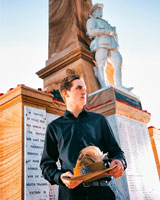Telling the Scenic Rim region’s unique war stories
The Scenic Rim Regional Council developed a year-long program of exhibitions, performances, events, forums, workshops, online resources and teaching kits to tell the stories of the fallen servicemen and women of the Scenic Rim. Events took place at libraries, cultural centres and heritage sites across the region from 31 January to 16 December 2015.
War Stories and our Town was based around six key themes:
- Women in War
- Anzac: A day in the life of
- Black Diggers
- I Witness
- Mend and Make do
- Our Stories.
Bronwyn Davies is the Coordinator of Cultural Services with the Scenic Rim Regional Council. She explains why the council took on such an ambitious project.
“The Anzac legend has a special place in the hearts of our community. War has shaped the character of who we are. For example, significant numbers of local men joined the Light Horse Brigade in both the First and Second World Wars; they were great horsemen.
“Farmers in the district were often exempt from serving as they were deemed essential to food supplies for the war effort (much to their chagrin). Many Indigenous diggers joined up from the district for all wars. As well, 35,000 American troops were stationed at Camp Cable to defend the Brisbane Line (they trained and recreated in this district), and of course Canungra is home to the Kokoda Barracks and the Museum of Military Intelligence and continues as a site of land warfare training and other military services.”
The council actively consulted with the local community and drew exhibition material and stories from individuals, RSLs and local museums.
A theatre piece, Cries of the Kalwun, developed by Goat Track Theatre Company and young people across the region was performed in heritage locations across the Scenic Rim later in 2015. Speaking before the project launched, Ms Davies hoped the legacy of the project would be strong.
“The project will result in a mass of community-developed resources, stories, recordings, cook books, learning kits and artworks. We believe there’ll be a renewal of heritage arts and crafts, and information that can be used in future public art projects,” she said.
“Of course we’re also keen to develop a stronger sense of identity and connection to place. And most importantly the project will illustrate how communities rallied to support each other, how they gathered to raise funds to support the war effort, how they dealt with loss and how they came together to have simple fun to help them cope when times were tough. We hope our program reflects these values.”









